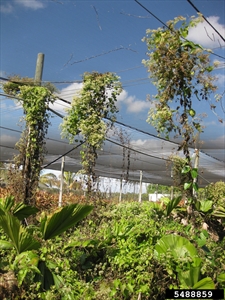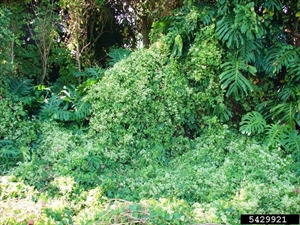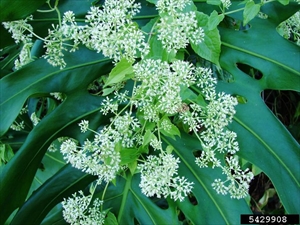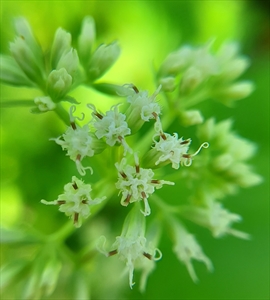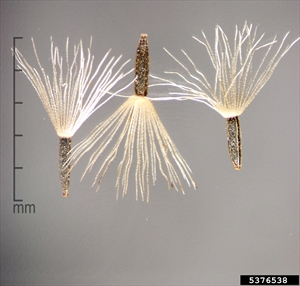- Widespread. Asia, Africa. North, South, Central America, Caribbean, Oceania. In most Pacific islands.
- Fast-growing, branched, long-lived, climbing vine (up to 25 m); smothering plantations (coconut, forestry, oil palm, cocoa), vegetable crops (taro), and native species, producing much seed; regrowing from stem cuttings. Thrives in open, sunny, disturbed situations, but tolerates partial shade. Produces chemicals inhibiting growth of competitors.
- Stems, up to 6 m, slender, ribbed lengthwise, few or no hairs, producing roots from stem-leaf junction. Leaves smooth, heart-shaped, shallow to toothed margins, up to 13 cm long, with stalks opposite along stem. Flowerheads, white or greenish-white, flat-topped clusters; flowers, 3-5 mm long, with protruding stamens. Seeds, black, thin, flattened, with fine, whitish bristles.
- Spread: vegetative propagation of stem pieces; seeds, by wind, animals, machinery, floodwater; intentionally as ground cover or soil conservation.
- Biosecurity: high risk of introduction; in Australia, 'restricted invasive plants': do not release into environment, give away or sell. Among 100 of World's Worst Invasive Alien Species (IUCN, 2020).
- Biocontrol: Rust, Puccinia spegazzinii, introduced into PNG, Fiji, Solomon Islands, Vanuatu. Psyllid, Heteropsylla spinulosa, released in Fiji, PNG, Samoa.
- Cultural control: hand weed, hoe or slash (but regrowth possible); plough; livestock (sheep, cattle) grazing; vehicle hygiene.
- Chemical control: in Australia: fluroxypyr; glyphosate; metsulfuron-methyl. Elsewhere, 2,4-D. In Fiji, glyphosate.
Pacific Pests, Pathogens and Weeds - Online edition
Pacific Pests, Pathogens, Weeds & Pesticides
Mile-a-Minute (466)
Mile-a-minute; it is also known as mikania, mikania vine, or Chinese creeper. CABI prefers bitter vine.
Mikania micrantha. Another species Mikania cordata is similar. Both are members of the Asteraceae.
AUTHORS Grahame Jackson, Aradhana Deesh & Mani Mua
Adapted from Mikania vine (Mikania micrantha) (2018) Weeds of SE Qld and Northern NSW. Lucidcentral. (https://www.lucidcentral.org/editors-pick-animal-and-plant-identification-keys/key-to-weeds-of-se-qld-and-northern-nsw); and additional information from CABI (2019) Mikania micrantha (bitter vine). Invasive Species Compendium. (https://www.cabi.org/isc/datasheet/34095); and Mikania micrantha. Waterhouse DF, Norris KR (1987) Biological Control Pacific Prospects. Inkata Press, Melbourne; and Mikania vine (Mikania micrantha) (2018) NSW Weedwise. Department of Primary Industries. NSW Government. (https://weeds.dpi.nsw.gov.au/Weeds/MikaniaVine); and from Mikania vine Mikania micrantha (2016) Biosecurity Queensland, Department of Agriculture and Fisheries. Photo 1 Andrew Derksen, USDA-APHIS, Bugwood.org. Photo 2-4 Dennis J. Giardina, Florida Fish and Wildlife Conservation Commission , Bugwood.org. Photo 6 Julia Scher, Federal Noxious Weeds Disseminules, USDA APHIS PPQ, Bugwood.org.
Produced with support from the Australian Centre for International Agricultural Research under project HORT/2016/185: Responding to emerging pest and disease threats to horticulture in the Pacific islands, implemented by the University of Queensland, in association with the Pacific Community and Koronivia Research Station, Ministry of Agriculture, Fiji.
